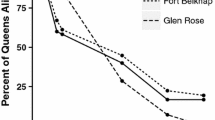Abstract
Incipient ant colonies are often under fierce competition, making fast growth crucial for survival. To increase production, colonies can adopt multiple queens (pleometrosis), fuse with other colonies or rob brood from neighboring colonies. However, different adoption strategies might have different impacts such as future queen fecundity or future colony size. O. smaragdina queen production was measured in incipient colonies with 2, 3 or 4 founding queens, following the transplantation of 0, 30 or 60 pupae from a donor colony. Pupae developed into mature workers, resulting in increased worker/queen ratios in pupae transplanted treatments and leading to increases in the per capita queen production. Conversely, more queens did not induce increased per capita fecundity. Thus, brood robbing added individuals to the worker force and increased future production of resident queens, whereas queen adoption increased the colony’s future production, but not the production of individual queens.

Similar content being viewed by others
References
Bartz SH, Hölldobler B (1982) Colony founding in Myrmecocystus mimicus Wheeler (Hymenoptera, Formicidae) and the evolution of foundress-associations. Behav Ecol Sociobiol 10:137–147
Børgesen L, Jensen PV (1995) Influence of larvae and workers on egg production of queens of the Pharaohs Ant, Monomorium pharaonis (L). Insectes Sociaux 42:103–112
Brian MV (1969) Male production in the ant Myrmica rubra L. Insectes Sociaux 16:249–268
Cassill DL, Vinson SB (2007) Effects of larval secretions on queen fecundity in the fire ant. Ann Entomol Soc Am 100:327–332
Colombel P (1970) Recherches sur la biologie et l’éthologie D’Odontomachus hæmatodes l. hym. formicoïdea poneridæ. Insectes Sociaux 17:199–204
Crozier RH, Newey PS, Schluns EA, Robson SKA (2010) A masterpiece of evolution - Oecophylla weaver ants (Hymenoptera: Formicidae). Myrmecological News 13:57–71
Gadau J, Strehl CP, Oettler J, Holldobler B (2003) Determinants of intracolonial relatedness in Pogonomyrmex rugosus (Hymenoptera; Formicidae): mating frequency and brood raids. Mol Ecol 12:1931–1938
Gibson RL, Scott JG (1990) Influence of cocoons on egg laying of colony founding Carpenter Ant queens (Hymenoptera, Formicidae). Ann Entomol Soc Am 83:1005–1009
Hölldobler B (1983) Territorial behavior of the Green Tree Ant (Oecophylla smaragdina). Biotropica 15:241–250
Hölldobler B, Carlin NF (1985) Colony founding, queen dominance and oligogyny in the Australian Meat Ant Iridomyrmex purpureus. Behav Ecol Sociobiol 18:45–58
Hölldobler B, Wilson EO (1990) The ants. Springer, Berlin Heidelbeg
Johnson RA (2004) Colony founding by pleometrosis in the semiclaustral seed-harvester ant Pogonomyrmex californicus (Hymenoptera: Formicidae). Anim Behav 68:1189–1200
Krag K, Lundegaard R, Offenberg J, Nielsen MG, Wiwatwittaya D (2010) Intercolony transplantation of Oecophylla smaragdina (Hymenoptera: Formicidae) larvae. J Asia-Pacific Entomol 13:97–100
Kronauer DJC, Gadau J, Holldobler B (2003) Genetic evidence for intra- and interspecific slavery in honey ants (genus Myrmecocystus). Proc R Soc Lond B Biol Sci 270:805–810
Mintzer AC (1987) Primary polygyny in the Ant Atta texana - number and weight of females and colony foundation success in the laboratory. Insectes Sociaux 34:108–117
Nonacs P (1990) Size and kinship affect success of co-founding Lasius pallitarsis queens. Psyche 97:217–228
Nonacs P (1993) The economics of brood raiding and nest consolidation during ant colony founding. Evol Ecol 7:625–633
Passera L (1972) Study on factors regulating fertility of queen ants, Plagiolepis pygmaea Latr (Hymenoptera, Formicidae). Insectes Sociaux 19:369–388
Peeters C, Andersen AN (1989) Cooperation between dealate queens during colony foundation in the green tree ant, Oecophylla smaragdina. Psyche 96:39–44
Peng RK, Christian K, Gibb K (1997) Distribution of the green ant, Oecophylla smaragdina (F.) (Hymenoptera: Formicidae), in relation to native vegetation and the insect pests in cashew plantations in Australia. Int J Pest Manag 43:203–211
Peng RK, Christian K, Gibb K (1998) How many queens are there in mature colonies of the green ant, Oecophylla smaragdina (Fabricius)? Aust J Entomol 37:249–253
Pollock GB, Rissing SW (1989) Intraspecific brood raiding, territoriality, and slavery in ants. Am Nat 133:61–70
Rissing SW, Pollock GB (1987) Queen aggression, pleometrotic advantage and brood raiding in the ant Veromessor pergandei (Hymenoptera, Formicidae). Anim Behav 35:975–981
Rissing SW, Pollock GB (1991) An experimental analysis of pleometrotic advantage in the desert seed harvester ant Messor pergandei (Hymenoptera, Formicidae). Insectes Sociaux 38:205–211
Sasaki K, Jibiki E, Satoh T, Obara Y (2005) Queen phenotype and behaviour during cooperative colony founding in Polyrhachis moesta. Insectes Sociaux 52:19–25
Sommer K, Hölldobler B (1995) Colony founding by queen association and determinants of reduction in queen number in the ant Lasius niger. Anim Behav 50:287–294
Strassmann JE (1989) Altruism and relatedness at colony foundation in social insects. Trends Ecol Evol 4:371–374
Tschinkel WR (1987) The fire ant, Solenopsis invicta, as a succesful “weed”. In: Eder J, Rembold H (eds) Chemistry and biology of social insects. Verlag Peperny, Munich
Tschinkel WR (1988) Social control of egg laying rate in queens of the Fire Ant, Solenopsis invicta. Physiol Entomol 13:327–350
Tschinkel WR (1992) Brood raiding and the population dynamics of founding and incipient colonies of the Fire Ant, Solenopsis invicta. Ecol Entomol 17:179–188
Tschinkel WR (1993) Resource allocation, brood production and cannibalism during colony founding in the Fire Ant, Solenopsis invicta. Behav Ecol Sociobiol 33:209–223
Tschinkel WR, Howard DF (1983) Colony founding by pleometrosis in the Fire Ant, Solenopsis invicta. Behav Ecol Sociobiol 12:103–113
Waloff N (1957) The effect of the number of queens of the ant Lasius flavus (Fab.) (Hym., Formicidae) on their survival and on the rate of development of the first brood. Insectes Sociaux 4:391–394
Acknowledgements
This study was funded by The Carlsberg Foundation (2009-01-0406) and strongly supported by Professor Keith Christian and Charles Darwin University who provided the necessary facilities.
Author information
Authors and Affiliations
Corresponding author
Rights and permissions
About this article
Cite this article
Offenberg, J., Peng, R., Nielsen, M.G. et al. The Effect of Queen and Worker Adoption on Weaver Ant (Oecophylla smaragdina F.) Queen Fecundity. J Insect Behav 25, 478–485 (2012). https://doi.org/10.1007/s10905-011-9311-7
Revised:
Accepted:
Published:
Issue Date:
DOI: https://doi.org/10.1007/s10905-011-9311-7




